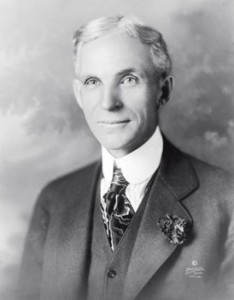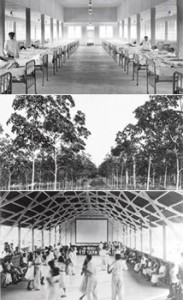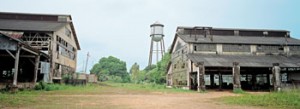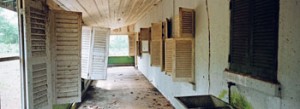 Reproduction from Fordlandia, by Greg GrandinIn November 1938, Joseph Goebbels enthusiastically attended the opening night of The Green Hell, a film directed by the German film director Eduard von Borsody, filmed largely in the Amazon jungle: “A valiant film, politically and artistically”, extolled the Nazi propaganda minister. The film, though inspired by a historical fact, was a fanciful defense of colonialism and its “hero” and main character was the English explorer Henry Wickham (1846-1928), who, after facing natives with poisoned arrows, piranhas, alligators and a huge anaconda, returns unscathed to England with 70 thousand seeds of Hevea brasiliensis, the rubber tree, determined to replant them in British Malaysia and thus destroy the Brazilian rubber monopoly. Curiously, that very same year, American tycoon Henry Ford (1863-1947), the founder of the Ford Motor Company and the fist businessman to resort to an assembly line to mass produce cars, traveled to Germany to receive, as a hero, a distinctive decoration for his support of Nazism and the anti-Semitic struggle (Hitler had a photo of him in his office). At the time, Ford told reporters that Fordlandia, the muddled American attempt to set up a rubber plantation in the Amazon Region from 1927 to 1945, was available to receive “undesired” Jews, as they “are my best workers back in America.”
Reproduction from Fordlandia, by Greg GrandinIn November 1938, Joseph Goebbels enthusiastically attended the opening night of The Green Hell, a film directed by the German film director Eduard von Borsody, filmed largely in the Amazon jungle: “A valiant film, politically and artistically”, extolled the Nazi propaganda minister. The film, though inspired by a historical fact, was a fanciful defense of colonialism and its “hero” and main character was the English explorer Henry Wickham (1846-1928), who, after facing natives with poisoned arrows, piranhas, alligators and a huge anaconda, returns unscathed to England with 70 thousand seeds of Hevea brasiliensis, the rubber tree, determined to replant them in British Malaysia and thus destroy the Brazilian rubber monopoly. Curiously, that very same year, American tycoon Henry Ford (1863-1947), the founder of the Ford Motor Company and the fist businessman to resort to an assembly line to mass produce cars, traveled to Germany to receive, as a hero, a distinctive decoration for his support of Nazism and the anti-Semitic struggle (Hitler had a photo of him in his office). At the time, Ford told reporters that Fordlandia, the muddled American attempt to set up a rubber plantation in the Amazon Region from 1927 to 1945, was available to receive “undesired” Jews, as they “are my best workers back in America.”
The “meeting” of Wickham and Ford, both of whom were linked to the highs and lows of Brazil’s rubber economy, one year before the conflict that would put the former’s colonialism in check and revolutionize the latter’s imperialism, making both of them dependent on this very same economy, reveals the notable and unlikely association of these two characters. When “stealing” the seeds and helping to transfer the rubber monopoly from Brazil to England, Wickham could hardly have imagined that, in 1922, only a few decades after his achievement, the English would give up their liberal line of discourse and be obliged to distort the rubber market, cutting their exaggerated production, to try and raise the price of rubber, previously worth gold. This turnaround, in turn, would push the Americans, and Ford in particular, as his immense automobile production required cheap rubber, to join the competition producing rubber trees in Brazil, a challenge to the British commercial “discourtesy”. The outcome of this American adventure was Fordlandia, an utopist project designed to recreate in the jungle the America that, according to Ford, had been corrupted by the capitalism that he himself had helped to strengthen. Along with its twin city, Belterra, both near the Tapajós river, it cost Ford more than 20 million dollars in the currency of that time. The investment initially foreseen in order to establish an efficient rubber plantation in Brazil, capable of meeting the internal demand of the Ford Company, was less than 2 million dollars. “In two decades, Ford spent millions of dollars and ended up without his plantation, which was devastated by a shortage of workers and plant disease, but with two ‘American’ towns, now abandoned, with central squares, sidewalks, Swiss style chalets, hospitals, stores, cinemas, golf courses, swimming pools and, of course, Ford model T cars driving around their unpaved streets”, explains historian Greg Grandin, an associate professor at New York University and author of Fordlandia: the rise and fall of Ford’s forgotten jungle city, to be released in the United States in June. Ironically, the life of Wickham has just been launched as well, under the title The thief at the end of the world, by Joe Jackson.

reproductionHenry Ford: Jungle utopiareproduction
The whole thing began in the Amazon region, when the Portuguese discovered the commercial use of the rubber tree back in 1750. When Charles Goodyear created the vulcanization process in 1839, which modified rubber and enabled it to be used at a high temperature, Brazil was the only country that had the raw material, though this was merely due to a “geographical accident”. Until the dawn of the twentieth century, the country accounted for 99 percent of the rubber worldwide. “Brazilian industry consisted of a structure based on direct extraction from the forest, with a shortage of manpower and total lack of competition. This system worked well enough for as long as the demand for rubber did not grow much and until a more rational form of exploiting rubber appeared on the competitive scene. Between 1900 and 1913, these circumstances vanished”, note the economists Zephyr Frank, from Stanford University, and Aldo Musacchio, from Ibmec. The global popularization of the bicycle gave birth to the “rubber boom”, which became even stronger as of 1900, thanks to the auto industry’s development. “The increase in demand caused prices to shoot up; this was a major incentive for other producers to enter the market. Wickham’s smuggling of the seeds, by solving the dilemma of the source of Brazil’s good quality rubber (up to the nineteenth century, several scientific expeditions attempted, unsuccessfully, to locate the right tree and to carry its seeds safely to London), caused the scales to tip toward Europe”, they comment. Asia was dominated by English and Dutch colonial systems, provided cheap manpower (unlike Brazilian manpower, expensive because it was scarce) and the ideal conditions for transforming its extraction into an organized and efficient industry, with low-cost plantations. “For as long as Brazilian rubber was harvested in the jungle, production could not exceed 40 thousand tons a year, no matter how good the price. This amount was insignificant in relation to rubber’s rising number of industrial uses”, writes Warren Dean in his work Brazil and the Struggle for Rubber.
The English took a while to start their plantations, but when they did, they unwittingly overdid matters. “The production of the oriental plantations grows more than market needs, accruing inventories and causing the product’s price to drop. The English government is therefore forced to intervene, with a production restriction policy, to impose higher prices; this was the so-called Stevenson Plan. The government and American firms, being caught unawares at the height of demand and in the face of industrial growth, started to preach a doctrine to the effect that ‘one must produce rubber under the control of the USA'”, explains economist Francisco de Assis Costa, from the University of Pará. “If the coffee oligarchies, which benefited from the government’s policies for raising the product’s value, had the doors of international financing open to them, the rubber oligarchy in the Amazon Region was abandoned and decadent, after the advent of the English plantations in Asia. When they learned about the USA’s plans, they promptly decided that ‘the Amazon Region wants the Americans.’ The possibility of acquiring capital merely by accepting the occupation of a remote region was, for them, a peerless opportunity to create an Amazon Region useful to the federation. What had been merely the Americans’ intent became the core of a national policy for the occupation of region, about which there was no policy”, Costa analyzes. In America, however, the battle cries of Herbert Hoover, then Commerce Secretary (and subsequently US president) for American entrepreneurs to invest in growing rubber in Latin America to avoid the English cartel, to the point of dispatching scientific expeditions to Brazil to this end, only met with the empathy of two entrepreneurs: Harvey Firestone, who preferred investing in plantations in Liberia; and Henry Ford, who, in 1924, had tried to grow rubber in Florida, to no avail.

reproduction /Hart Preston/lifeVargas visits Belterra in 1940. Ford’s portrait in the backgroundreproduction /Hart Preston/life
“However, it was not merely the pursuit of cheaper sources of raw materials that led Ford to turn toward Brazil. At the age of 60, he was disillusioned with the direction of America. He said he found himself frustrated with domestic politics and he abominated the United States’ adhesion to war, the unions, Wall Street, the energy monopolies, the Jews, modern dance, Roosevelt and his New Deal, cigarettes, alcohol and the rising government intervention in business”, comments Grandin. “It was a sort of ‘American pastoral setting’ that saw no opposition between nature and industrialization. For people such as Ford, it was possible to bring together agriculture and industry, as mechanization would not underscore the conquest of nature, but, rather, the realization of its ‘secrets’. He believed that Americans had a mission to recreate the capitalist Eden”, he adds. “We are not going to Brazil to make money, but to help to develop that wonderful and fertile land. We will train the Brazilians and they will become excellent professionals, like ours”, stated Ford. Paradoxically, notes Grandin, the same man that helped to free the power of industrialization and that revolutionized human relations spent the rest of his life trying to put the genie back in its bottle. “Fordlandia represents, in a crystal clear way, the utopia that drove Ford and, consequently, ‘Americanism’. It reveals the belief that the movement toward greater efficiency can be manipulated in such a way that technology, if devoid of government interference, can solve any social problem that ensues from progress”, analyzes the historian. Fordlandia, therefore, seems like a parable of arrogance, but of a different sort, merely a show of Ford’s power to control untamed nature. “The true arrogance of the undertaking was that he believed that the powers of capitalism, once freed, could be controlled by his will”, believes Grandin.
After trying to recreate his Eden in the American Midwest, a frustrated Ford received, in 1925, a visit from José Custódio de Lima, a Brazilian diplomat who for two years had been courting the industrialist with offers to invest in Brazil. However, this time he had carte-blanche from the governor of the state of Pará to offer the American land grants and tax exemptions. Since 1914, the Ford Company had been operating in Brazil and, that year, the firm held a national monopoly where vehicles were concerned. The Brazilian elite regarded Ford as a “twentieth century Moses”, in the words of an important São Paulo industrialist (who was perhaps unaware of Ford’s anti-Semitism). The author Monteiro Lobato, who had translated Ford’s biography into Portuguese, saw in him the “Jesus Christ of industry”, whose life was “the messianic gospel of the future”. One cannot deny the merit of the man who, in conversation with Lima, upon learning that a rubber tapper earned fifty cents of a dollar per workday, said that “it was necessary to pay at least five dollars, because Brazilians should not work as slaves”. The Amazonian press, upon hearing of Ford’s interest, became highly enthusiastic. “The newspapers that are against it are classified as ‘red newspapers’. While the press rejoiced at the arrival of foreign capital, ‘these leftists’, wrote an editorialist of that time, ‘move this campaign from discredit, criminal and ungrateful, that reflects the smallness of these patriots that want to save the country; but the bark of these mongrels will be unable to scare Ford’s dollars away from the fruitful Amazon Region’. There is also strong criticism voiced by the people from São Paulo, in particular by the students who, supposedly, according to the Pará newspapers, recall the region not to help it, but to protest against foreign capital”, narrates Elaine Lourenço, a geographer from the Nove de Julho University Center. The story even included the typical con man: Jorge Dumont Villares, a nephew of the aeronaut Alberto Santos Dumont. According to Grandin, being aware of the Americans potential interest in the region, Villares allegedly forged an alliance with American employees, including a consul and a member of the scientific commission sent to Brazil in 1923, to guarantee, vis-à-vis the Pará government, an option on the purchase of an area of 2.5 million acres in Tapajós valley. When Ford sent a team to assess the best place for his rubber plantation, the historian tells us, they were only shown the area under the control of Villares, which made a profit of US$ 125 thousand on land that the Pará authorities had intended to simply donate to the American undertaking. Even the Ford appraiser apparently joined the racket, describing the region “in hues worthy of a Dickens novel, ready to awaken in Ford the desire to intervene and save that population from degradation, vice, alcohol and poverty”. “To confirm that the thought process that impelled Ford toward the Amazon Region went beyond the laws of supply and demand, when he received the description of the region, he was already aware that the English cartel was about to be dismantled, because the Dutch had not joined it. Ford was advised to give up the notion of the plantation, but he went ahead with it, even though rubber prices were falling”, Grandin tells us. “I’ll go and visit my land by plane, with my friend Charles Lindbergh”, said Ford, when he revealed his plans to the press.

reproduction Hospital, plantation and traditional dance: Ford’s city in its heydayreproduction
He never did come, but two ships arrived in Brazil in 1927 with enough cutting-edge technological material to create an “American city” in the jungle. The contract for the creation of the undertaking in the Amazon Region explained that there would be no kind of Brazilian inclusion in the Ford activities in Brazil. The following year, when the Ford operations actually began, Henry Wickham died. He had been nicknamed “Henry I”: remembering his past “treachery”, the Brazilian press started to question the “Yankee invasion” in the Amazon Region. Things really were not going well: the firm’s first director, who had barely arrived, made several mistakes, including deforesting a large area for the facilities, thereby destroying the precious wood that Ford regarded as a means of recouping part of his investment. The new man in charge was the captain of the boats that had carried the material, in keeping with Ford’s suspicion of specialists; this was a mistake that would come to be fatal for the undertaking. “The structuring of the firm was based on using advanced equipment, on a clear division of labor, and on capitalistic production relations that clashed with the mentality of the local manpower. There was a lack of basic social capital and an absence of scientific know-how when it came to planting and, above all, no job market of the magnitude that the undertaking required”, analyzes Costa. A company survey had indicated a potential of 30 thousand men, a reasonable number for the business to prosper along Ford’s lines. The reality, however, was different: “There are a number of jobless people wandering about, but when you talk to them about work, the answer to your face is that this kind of work does not interest them. They prefer seasonal work, whether as farm hands or tapping rubber trees, and few are interested in Fordlandia”, exclaimed an exasperated American executive.
“With relatively free access to land and to the resources of nature, thereby with access to the means of subsistence, the workers refused to submit to Ford’s manufacturing system, with timetables, uniforms, time cards, factory whistles and salaries”, explains Costa. A moralist, Ford prohibited alcohol consumption and prostitution within this factory’s gates, which forced workers to “escape” to nearby areas, nicknamed “Island of the Innocent”, which became centers of crime and violence. Likewise, the Americans had no interest in getting closer to the Brazilians. A joke from those times stated that after one year in Fordlandia, an American could say “one beer” in Portuguese; after two years, he could say “two beers”. The homes, built along the lines of American houses, were ill-suited to the weather and the Brazilian temperament, with their low roofs and large windows that allowed mosquitoes to fly in. Still, the homes were regularly visited by sanitary inspection agents, who demanded that the workers comply with hygiene habits, both at home and in the street. There was school for the children and the relatively high wages were paid on time. Ford also recommended that one should plant flowers in the windowboxes, in order to prettify the place of work. However, the personnel hated the time clock, as their time was regulated, along the lines of modern capitalism, with whistles and inspectors. Ford demanded that the food be healthy, so that the local backwoodsmen saw themselves forced to eat oatmeal for breakfast and to give up beans and flour. The mere change in the food system created a crisis that put the lives of the Americans at risk. Instead of being served by women, the workers, one fine day, were faced with a cafeteria and trays. This raised a general cry that “We aren’t dogs”. The Ford team was forced to spend the night in boat in the middle of the river and had to be rescued the next day by the police. And the workers went back to eating their beans.

Colin McPherson/CorbisPhantom Fordlandia: warehouses and water tower with factory whistleColin McPherson/Corbis
Given the shortage of manpower, the insistence on applying Ford’s methods to the region, and very little knowledge of rubber tree husbandry, the enterprise did not prosper. “In 1929, the firm had already spent more than US$1.5 million and had little to show for it. Some 95% of the seeds planted did not germinate or died, and half of the wood removed was lost, when it was burnt. Fordlandia was growing strongly, but its elaborate facilities were divorced from the project’s core business: producing rubber. Only in 1933 did the company, in despair, turn to James Weir, an agricultural technician who had worked with rubber trees in Asia”, says Grandin. Weir’s proposal, given the disease that was consuming the trees, was radical: to abandon Fordlandia, which would become the site of experiments to fight leaf disease, and establish a new plantation in Belterra. “In the opposite direction of Wickham’s seed smuggling, Weir proposed that new hybrids be imported from Malaysia, precisely those that had been generated as a result of the Englishman’s piracy. To make matters worse, the new site chosen was near where Wickham had got his seeds 57 years earlier”, reveals the historian. As if this were not enough, the enterprise clashed with the local government, which regarded the import as a repetition of the dirty trick by the English. Luckily for Ford, the 1930 revolution put Vargas in office and his type of nationalism was capable of coming to terms with foreign capital, especially when it came to fulfilling his promise to recover the Amazon Region. At the Ford family’s invitation, Vargas visited Belterra in 1940 and saluted the American work there as an example to be followed. “Nonetheless, the Ford Company in Brazil was incapable of structuring itself, whether for profit or for meeting its parent company’s needs. This was due to its inability to form a sufficient mass of the means of production to get rubber. Unable to forcibly subordinate a large enough number of workers, the firm did not reach profitable production levels or large scale production”, observes Costa.

Colin McPherson/CorbisHome in the American Midwestern style in Fordlandia, todayColin McPherson/Corbis
World War II and the need for rubber, given that British Asia, by then, was in the hands of the Japanese, gave rise to an attempt to revive the Ford undertaking, with the arrival of American technicians and the investment of Washington money (to the horror of Ford, a liberal republican). After all, as President Roosevelt said: “One can’t carry out a modern war with no rubber”. The international effort and the recruiting of the so-called “rubber soldiers” did not change the awful state of Fordlandia and Belterra, however. In 1937, 1,200 acres were deforested in order to plant more than 2.2 million seeds. In 1941, the number rose to 3.6 million. By 1942, however, production had still not progressed beyond a mere 759 tons of rubber, a fraction of the 45 thousand tons extracted during the rubber boom heydays. After spending US$ 20 million, Ford sold the entire enterprise to Brazil for US$ 500 thousand.
“In 1945, when World War II ended, given the possibilities of the new synthetic rubber, the very specialization of Ford (which was now focusing solely on automobiles), and natural and human resistance, the firm returned its concession to the Brazilian government, who indemnified it for the improvements made to the property”, notes Elaine Lourenço. In 1950, the two towns were abandoned. “In May 1951, the first load of latex from Singapore arrived at the port of Santos, produced from the trees that descended directly from the seed stolen by Wickham precisely 75 years earlier. Ever since, Brazil has had to import latex to meet its rubber requirements”, completes Grandin. As it turned out, when it came to creating a rubber empire, the colonial adventurer Henry I was far more successful than the modern entrepreneur Henry II.
Republish